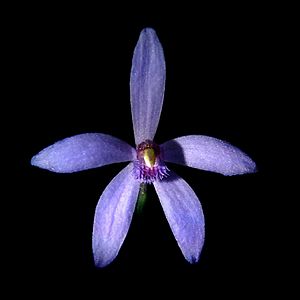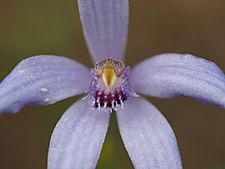Blue fairy orchid facts for kids
Quick facts for kids Blue fairy orchid |
|
|---|---|
 |
|
| Pheladenia deformis | |
| Scientific classification | |
| Genus: |
Pheladenia
|
| Species: |
deformis
|
| Synonyms | |
The Pheladenia deformis, often called the blue fairy orchid or blue beard, is a special kind of flowering plant. It is the only species in its group, Pheladenia, which belongs to the orchid family. This beautiful plant grows only in Australia.
It has had a few different names over time, but its current name is Pheladenia deformis. These orchids have a single, thin, hairy leaf. Their flowers are usually blue and have unique parts. The sepals and petals are quite short and wide. The most interesting part is its labellum, which is a special lip-like petal.
Contents
What Does the Blue Fairy Orchid Look Like?
The blue fairy orchid is a perennial plant. This means it lives for more than two years. It grows from a tuber (a swollen underground stem). This tuber helps the plant store food.
Each plant has one hairy leaf at its base. The leaf is long and narrow, about 3 to 10 centimeters (1 to 4 inches) long. It is also quite thin, only 2 to 5 millimeters (0.08 to 0.2 inches) wide. You might see small hairs on its edges.
Usually, there is just one flower on a stem. This stem can be 5 to 15 centimeters (2 to 6 inches) tall. The flower has three sepals and two petals. These parts are about 14 to 20 millimeters (0.5 to 0.8 inches) long. They are also 3 to 5 millimeters (0.1 to 0.2 inches) wide.
The inside of the flower parts is usually bright blue. Sometimes, they can be white, pink, or yellow. Like other orchids, one petal is very different. This is the central labellum, or "lip." The labellum is dark blue at its tip and white near its base. It is about 10 to 14 millimeters (0.4 to 0.6 inches) long. The edge of the labellum has a fringe. It also has many stalked structures called calli. These calli look like a beard, which is why it's sometimes called "blue beard."
How the Blue Fairy Orchid Got Its Name
The blue fairy orchid was first officially described in 1810. A botanist named Robert Brown gave it the name Caladenia deformis. He wrote about it in his book Prodromus Florae Novae Hollandiae. He found a sample of the plant in Tasmania, near what is now George Town.
Over the years, scientists have studied the plant more. In 2000, Stephen Hopper and Andrew Brown changed its name to Cyanicula deformis. Then, in 2001, David Jones and Mark Clements gave it its current name, Pheladenia deformis.
The name Pheladenia comes from old Greek words. Phelos means "deceitful," and aden means "gland." This refers to the special labellum of the orchid. The word deformis is Latin for "misshapen." This also describes the unusual shape of its labellum.
Where the Blue Fairy Orchid Lives
The blue fairy orchid can grow in many different places. You can find it near swamps, on granite rocks, in heathlands, woodlands, and forests. It grows in all Australian states except Queensland and the Northern Territory.
In Western Australia, it is found from north of Kalbarri all the way to Israelite Bay on the south coast. In New South Wales, it is not very common. However, it sometimes grows in groups in the Central West Slopes and South West Plains, south of Molong.
Is the Blue Fairy Orchid Endangered?
The Western Australian Government's Department of Parks and Wildlife has looked at the blue fairy orchid. They have classified Pheladenia deformis as "not threatened" in Western Australia. This means it is not currently at risk of disappearing.


